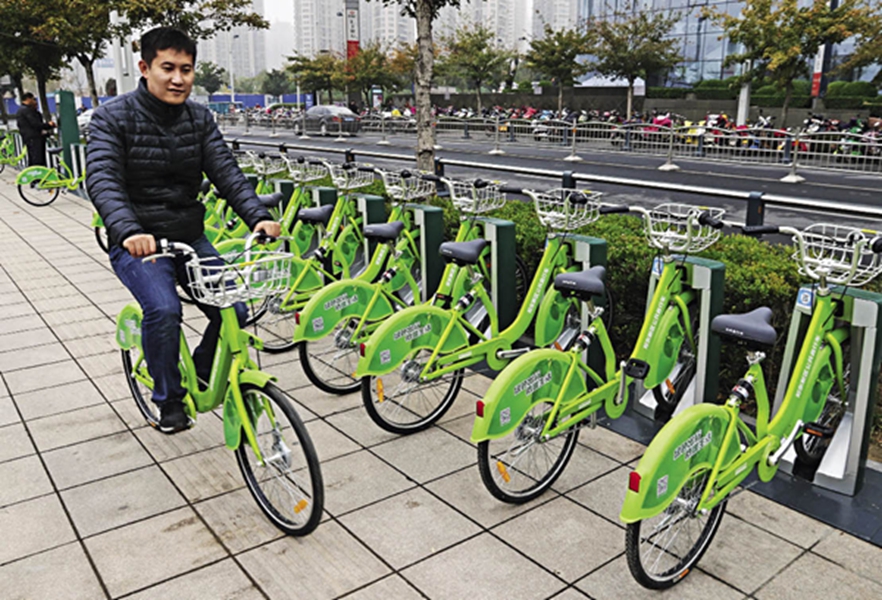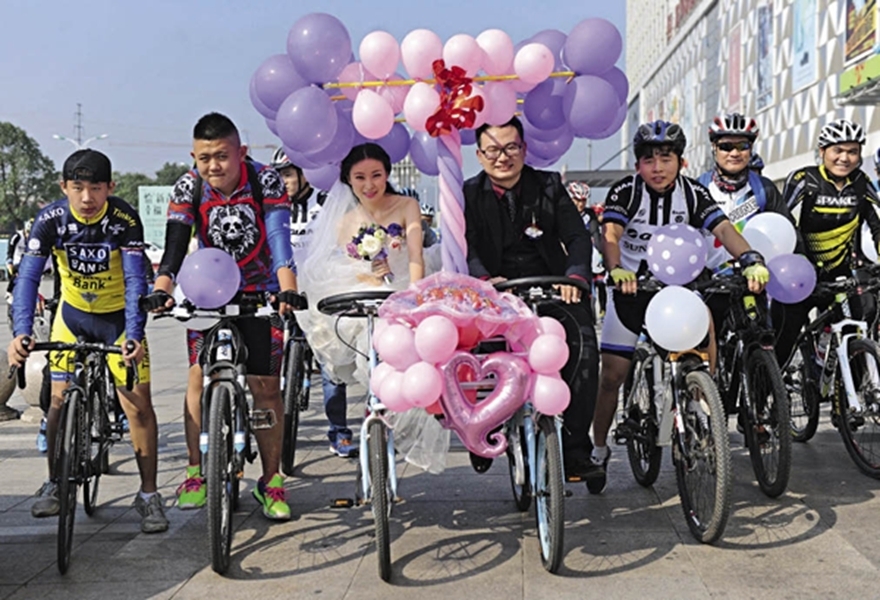By staff reporter GONG HAN
TRAFFIC jams, air pollution and the need to conserve energy have motivated the Chinese government to promote non-motorized transportation, namely bicycling and walking.
Non-motorization is the utmost goal of green transportation. It is also a mode various countries have explored in endeavors to build eco-cities. The Chinese government has also been working to achieve this end over the past several years. In 2013 the Ministry of Housing and Urban-Rural Development issued the Guideline on Promoting Construction of Urban Bicycle and Pedestrian Transportation Systems. Also in the pipeline is a Guide to City Planning and Transportation Design in cities at various levels. Suggestions raised in the 13th Five-Year Plan also maintain that, “low-carbon transportation will be promoted, public transportation will be prioritized, rail transit will be enhanced, and green transportation such as bicycles will be encouraged.”
Cycling and walking were formerly the norm in China. In the 1970s and 1980s the Middle Kingdom was indeed the undisputed “Kingdom of Bicycles.” But starting from the year 2000, the number of cars spiked. Popularizing a return to the good old car-free days, therefore, will be no easy task.
People-oriented Transition
By the end of 2014, the number of auto vehicles in China had hit 264 million, 154 million of them cars. Estimates show that if the growth rate of cars in China were to slow by two to three percentage points annually, oil consumption would drop 5.8 million tons and carbon emissions would be reduced by 17.80 million tons per year.
Deputy Director of the Institute of Transportation Engineering at Tsinghua University Dr. Yang Xinmiao, however, believes that this is unlikely, due to China’s expanding car production capacity, falling energy prices, and the rapid development of new energy vehicle technologies.
“By 2050, every household in China will own a car that runs through one of a number of energy types. But although inevitable, this trend doesn’t mean that people can drive daily with impunity. Relying solely on cars will place an impossibly heavy burden on our cities and the environment generally,” Yang Xinmiao said in our interview.
In efforts to promote non-motorized transportation, the Ministry of Housing and Urban-Rural Development has since 2010 conducted three pilot programs in 95 cities. The guideline clearly stipulates that mega- and big cities should promote walking and cycling for medium and short distances, and connections between public transportation systems. Small and medium-sized cities, meanwhile, should promote walking and cycling as main transportation modes.
Hangzhou is a perfect example in this sense. Its public bicycle system leaves a deep impression on every visitor.

A thousand brand-new bikes for rent are neatly placed in 34 service stations in Zhengdong New District CBD of Zhengzhou, Henan Province.
After years of development, Hangzhou now has the world’s largest public bicycle system. It includes 84,100 public bicycles and 3,354 service stations at 300-meter intervals. Their first hour of use, moreover, is free of charge. BBC Travel Channel has rated Hangzhou as one of the world’s eight cities offering the best public bicycle service in 2011.
Statistics show that non-motorized transportation accounts for 65 percent of total traffic in Hangzhou’s main urban area. Also that bicycle rentals total 450,000 times per day. Hangzhou residents showed a clear preference for bicycles in a survey entitled “Your ideal commuting method.” Their reasons include the city’s humanized public bicycle system, including spacious, uninterrupted bicycle and pedestrian lanes, shelters for cyclists and pedestrians near traffic lights, more consideration on the part of auto drivers as regards giving way to bicycles and pedestrians, and various information services such as bicycle parking and renting locations.
One hundred and forty other Chinese cities have benefited from Hangzhou’s experience. Shenzhen, Xiamen, and Kunming have bicycle routes circling lakes and along coastlines. Jinan is also looking at adapting one of its current four auto-traffic lanes for the use of bicycles and pedestrians. “A main feature of walking and cycling is that if you embrace it and improve the design, it will grow,” Ministry of Housing and Urban-Rural Development expert Jiang Binglei said.
Guangzhou, in contrast to Hangzhou, provides the chance to learn from mistakes rather than from tried and true experience.
There have been daily traffic jams in Guangzhou since the 1990s. While vigorously promoting public transportation, Guangzhou also elected to limit bicycles on the road to make room for more cars. For example, bikes were forbidden on main roads during rush hours, while cars were permitted in bicycle lanes. By 2010, the ratio of bikes in Guangzhou’s transport system had dropped from 33.8 percent to 13.3 percent.
“Road designation and traffic control damaged the eco-system for bikes and motor bikes. They have still not recovered from this major setback, even though it has been proven that cars have a far more negative influence on traffic than bikes,” senior engineer at the Guangzhou Road Engineering Research Institute Zeng Ying said. In the last several years, Guangzhou has tried to reintroduce non-motorized transportation by building more greenways for cycling and walking. By June 2015, Guangzhou had constructed a total 2,763 kilometers of greenways covering 3,600 square kilometers and providing service for eight million people.
City planning and transportation management authorities need to resolve the issues that constrain bicycle use, such as road designation, continuity of facilities, and safety.
Changing Mentality
“People’s mentality is what many believe to be the greatest hurdle to promoting non-motorized transportation,” Jiang Binglei, China’s first female PhD in transportation who has worked for years in Ministry of Housing and Urban-Rural Development, said in our interview. She once read in a survey that 40 percent of China’s consumers buy cars in order to gain social status. In a country where cars have only recently become popular, most families are naturally more than willing to own them.
Statistics show that, compared to other metropolises like Tokyo and Seoul, China’s average car ownership is the lowest, yet the usage rate is the highest. Even certain experts and decision-makers have displayed this kind of mentality, Jiang Binglei said. When she was at college, all her teachers carried out research on how it was possible for more Chinese to own cars. They believed that cars carried greater status than cycling and walking – a mindset that has to an extent made certain cities reluctant to invest capital and energy in non-motorized vehicles.

Bike wedding of Hao Ruidao and Liang Tingting in Chuzhou, Anhui Province.
“But the way Chinese people think is changing, as I see from my family and friends,” Jiang Binglei said. She totally understands Chinese people’s dependence on cars at the current stage. She compares car ownership to that of electric drills, in the sense that many families have them but do not necessarily use them every day.
Yang Xinmiao lives in Beijing and has two cars, but to save time he prefers to cycle to work. “Driving takes 15 minutes at best and one hour and 15 minutes at worst. But if I cycle I can always get to the office within 20 minutes.”
The average commuting distance in the U.S. is 20 kilometers, but in China it is less than seven kilometers. Traveling by pushbike or electric bike is thus perfectly feasible.
“It hasn’t been long since the Chinese solved their food and clothing issues, so it will take some time to change their way of thinking. It may take 10 years for some, five years for others, and perhaps a whole lifetime for others still. But it doesn’t matter. Let’s do it step by step. China’s great advantage in promoting non-motorized transportation is our collective memory of bicycles. Most adults have cycled to work or school, which sets us apart from other countries. We should find it entirely possible to return to something that was once a staple in our lives,” Yang Xinmiao said.
Yang thinks that in future there will be multiple means of transportation in China. What the government needs to do, therefore, is to provide the conditions that will enable their balanced development.
Smog is an inconvenient yet inevitable topic in Beijing. Considerable numbers of people decide not to cycle because of poor air quality, according to a Beijing Transportation Development Research Center survey. “This is a contradiction. Green travel is a major way of improving air quality. I think our first option should be public transport and, when weather permits, bicycling. If smog is serious, we do not recommend excessive outdoor activity. But for anyone that prefers to cycle we can suggest protective measures,” Director of the Planning Department of Beijing Transportation Development Research Center Yao Guangzheng said.
Lead Our Own Way
“The Chinese government has attached unprecedented importance to the development of non-motorized transportation,” said Zong Yan, transport specialist at World Bank Beijing Office. The World Bank started to work with the Chinese Ministry of Housing and Urban-Rural Development in 1995. That year the Ministry held a symposium in Beijing on city transportation to which it invited World Bank and Asia Development Bank representatives. The Beijing Declaration was issued during the conference, the first chapter of which is entitled “The aim of transportation is the movement of people and objects, not vehicles.”
“This definition came as a shock to Chinese decision-makers,” Zong Yan said in our interview.
“Every city has its unique features, so international experience may not be applicable to China. In fact, even the U.S. and Europe are quite different. The American model of ‘living in the suburbs and commuting to work’ began at the end of World War II. The first energy crisis in the 1970s made Americans reflect on this and try to reduce their dependence on cars. But it had already become hard to return to non-motorized transportation. Some problems in Chinese cities occur due to American influence, driven by both a misled development philosophy and irrational pursuit of GDP,” Zong Yan said.
Zong Yan believes that what China needs to do first of all is to make changes at source. This means making city planning and road design more bike and walk friendly. Second, land-use must be more intensive and diverse to encourage people to cycle or walk short distances. Finally, “people-oriented transportation” that serves local people and meets different demands must be promoted.
“The Ministry of Housing and Urban-Rural Development is doing a good job in focusing on guidelines and training – both important factors. But that most essential is a people-oriented philosophy. Both the government and market should also be given a role to play,” Zong Yan said.
“To promote non-motorized transportation, China needs to find its own way. This calls for large-scale innovation.” Yang Xinmiao went on to tell us that in 2008 a team from Tsinghua University set up a website encouraging volunteers to replace driving with walking and cycling. The initiative achieved an estimated 9,000-ton reduction in carbon emissions, so earning RMB 300,000 through carbon trading. It gave Yang inspiration. “Take the aviation industry for example. It emits enormously, but is totally capable of buying emission quotas. These funds could be used to subsidize people who walk and ride. Or drivers could split them with cyclists. This is entirely feasible, bearing in mind current technologies. And material incentives are highly likely to produce effective results.”
Jiang Binglei gave us some statistics: If you ride 15 minutes each day or cycle four kilometers (shorter than the average commuting distance), you will burn calories equal to 4.5 kilos; and walking or cycling 10 to 20 minutes every day is both the easiest and healthiest way of commuting.
For a country whose obese population is second only to that of the U.S., this really counts.
